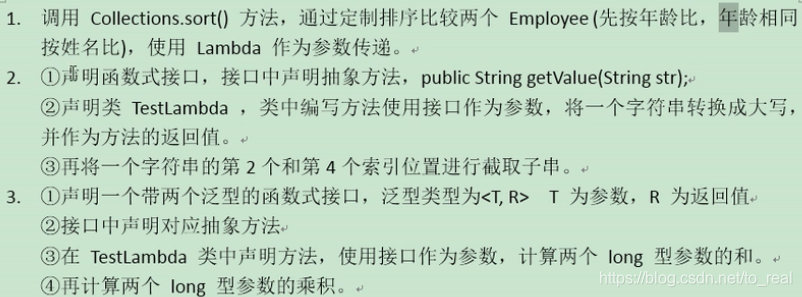
public class TestJava83 {
List<Employee> emplpoyees = Arrays.asList(
new Employee("张四",33,988.88),
new Employee("张三",23,888.88),
new Employee("张吴",43,9988.88),
new Employee("张六",53,8998.88));
//需求1:调用Collections.sort方法,自定义排序,Employee先按年龄排序,再按名称排序
@Test
public void test01(){
Collections.sort(emplpoyees,(e1,e2)->{
if(e1.getAge()==e2.getAge()){
return e1.getName().compareTo(e2.getName());
}else{
return Integer.compare(e1.getAge(),e2.getAge());
}
});
emplpoyees.forEach(e->{
System.out.println(e);
});
}
//需求2:定义函数式接口MyFunInter,接口中定义方法getValue,声明类,类中方法 将接口作为参数,将传入的字符串参数转大写,截取
@Test
public void test02(){
System.out.println(toCast("hello wangmeng", x -> x.toUpperCase()));
System.out.println(toCast("hellowangmeng", x -> x.substring(2,4)));
}
//策略设计模式
public String toCast(String data, MyfunInter mfi){
return mfi.getValue(data);
}
//需求3:
@Test
public void test03(){
System.out.println(longMethod(2l, 5l, (x, y) -> x + y));
System.out.println(longMethod(2l, 5l, (x, y) -> x * y));
}
//策略设计模式
public Long longMethod(Long t1,Long t2, MyFunInter2<Long, Long> mfi2){
return mfi2.myMethod(t1,t2);
}
}

 Java8 Lambda表达式与函数式接口实践
Java8 Lambda表达式与函数式接口实践





 本文通过具体示例介绍了Java8中的Lambda表达式和函数式接口的使用,包括自定义排序、字符串处理及数值运算。通过策略设计模式展示了如何利用函数式接口进行灵活的代码设计。
本文通过具体示例介绍了Java8中的Lambda表达式和函数式接口的使用,包括自定义排序、字符串处理及数值运算。通过策略设计模式展示了如何利用函数式接口进行灵活的代码设计。
















 1293
1293

 被折叠的 条评论
为什么被折叠?
被折叠的 条评论
为什么被折叠?








